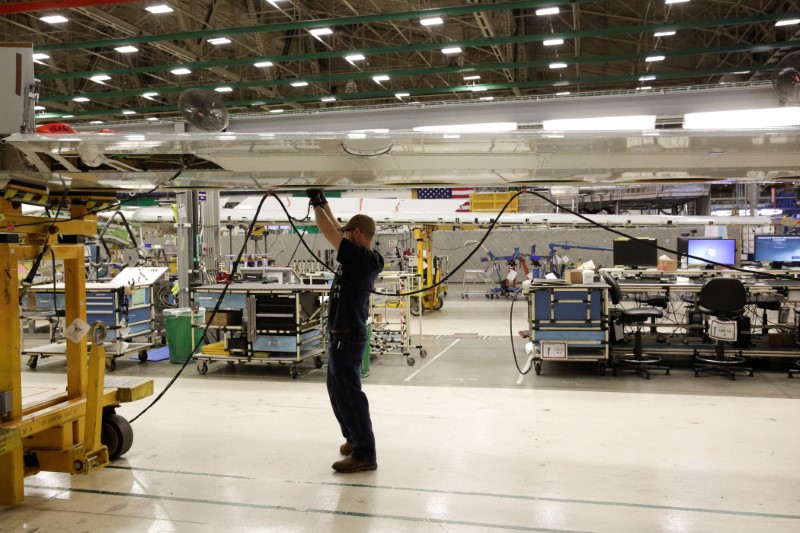By Lucia Mutikani
WASHINGTON (Reuters) – The U.S. economy grew faster than initially thought in the third quarter, notching its quickest pace in three years, buoyed by robust business spending on equipment and an accumulation of inventories.
Gross domestic product expanded at a 3.3 percent annual rate last quarter also boosted by a rebound in government investment, the Commerce Department said in its second GDP estimate on Wednesday. That was the fastest pace since the third quarter of 2014 and a pickup from the second quarter’s 3.1 percent rate.
The economy was previously reported to have grown at a 3.0 percent pace in the July-September period. It was the first time since 2014 that the economy experienced growth of 3 percent or more for two straight quarters.
The growth pace, however, likely exaggerates the health of the economy as inventories, goods yet to be sold, accounted for nearly a quarter of GDP growth. Excluding inventory investment, the economy grew at a 2.5 percent rate. When measured from the income side, output also expanded at a 2.5 percent rate.
“While welcomed improvement, the sustainability of growth has been reliant on pent-up demand and stockpiling of goods after grossly depleting inventories,” said Lindsey Piegza, chief economist at Stifel Fixed Income in Chicago. Economists had expected that third-quarter GDP growth would be raised to a 3.2 percent rate. The brisk growth pace strengthens the case for the Federal Reserve to raise interest rates next month. The U.S. central bank has increased borrowing costs twice this year.
Fed Chair Janet Yellen told lawmakers on Wednesday “the economic expansion is increasingly broad based across sectors,” and that she expected that “the economy will continue to expand.”
Prices for U.S. Treasuries fell on the data and Yellen’s remarks. The dollar was little changed against a basket of currencies, while stocks were mixed.
The economic recovery since the 2007-2009 recession is now in its eighth year and showing little signs of fatigue. The economy is being powered by a tightening labor market, which has largely maintained a strong performance that started during former President Barack Obama’s first term.
Economists see a modest boost to growth from efforts by President Donald Trump and his fellow Republicans in Congress to push through a broad package of tax cuts, including slashing the corporate income tax rate to 20 percent from 35 percent.
Trump wants lower taxes to lift annual GDP growth to 3 percent on a sustained basis. The fiscal stimulus would, however, come when the economy is at full employment.
“Corporate and personal income tax cuts will have minimal impact on growth over the longer run,” said Gus Faucher, chief economist at PNC Financial in Pittsburgh. “In 2019 and beyond growth will settle in to its long-run average of 2 percent to 2.25 percent.”
CORPORATE PROFITS RISE
The government said after-tax corporate profits surged at a 5.8 percent rate last quarter after rising at only a 0.1 percent pace in the second quarter. Undistributed profits jumped at a 13.9 percent rate after declining for two straight quarters, suggesting that companies were anticipating deep tax cuts.
Businesses accumulated inventories at a $39.0 billion pace in the third quarter, instead of the previously reported $35.8 billion rate. As a result, inventory investment contributed 0.8 percentage point to third-quarter GDP growth, up from the previously reported 0.73 percentage point.
That suggests inventories could be a drag on growth in the fourth quarter. Data on Tuesday showed a drop in wholesale and retail inventories in October, leading economists to slash their fourth-quarter GDP growth estimates by as much as five-tenths of a percentage point to as low as a 2.3 percent rate.
The Fed on Wednesday in its Beige Book report of anecdotal information on business activity collected from contacts nationwide described economic activity as having “continued to increase at a modest to moderate pace in October and mid-November.”
Growth in consumer spending, which accounts for more than two-thirds of the U.S. economy, was revised down to a 2.3 percent rate in the third quarter from the previously reported 2.4 percent pace. Consumer spending increased at a robust 3.3 percent rate in the second quarter.
The deceleration in consumer spending likely reflects the impact of Hurricanes Harvey and Irma, which struck Texas and Florida during the third quarter. Spending is also being constrained by sluggish wage growth, which is forcing households to dip into their savings to fund purchases.
The government cut its estimate for the increase in second-quarter wages and salaries by $26.5 billion. The saving rate decreased to 3.3 percent in the third quarter from 3.7 percent in the April-June period.
Economists say savings cannot drive consumer spending indefinitely. But they also believe that income growth is being understated, pointing to a 4.1 percent unemployment rate as well as strong business investment.
Growth in business investment in equipment was raised to a 10.4 percent pace, the fastest in three years, from the previously reported 8.6 percent rate. Businesses also increased spending on software.
But investment in nonresidential structures fell at a 6.8 percent pace in the third quarter, the biggest drop since the fourth quarter of 2015, instead of the previously estimated 5.2 percent rate. That is largely because of a slowdown in spending on mining exploration, wells and shafts.
Growth in government spending was raised to a 0.4 percent rate. Government outlays were previously reported to have declined at a 0.1 percent pace in the third quarter. Government spending had contracted for two consecutive quarters.
(Reporting by Lucia Mutikani; Editing by Andrea Ricci)










